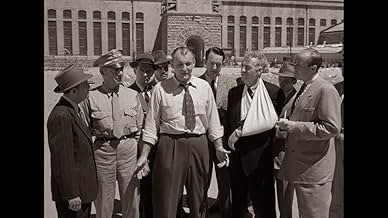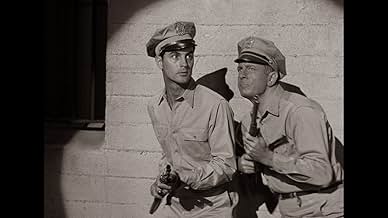Aggiungi una trama nella tua linguaFed up with the inhumane prison living conditions, a general prison riot breaks out, leading to hostage-taking, a stand-off with the guards and eventual negotiations with the prison administ... Leggi tuttoFed up with the inhumane prison living conditions, a general prison riot breaks out, leading to hostage-taking, a stand-off with the guards and eventual negotiations with the prison administration officials.Fed up with the inhumane prison living conditions, a general prison riot breaks out, leading to hostage-taking, a stand-off with the guards and eventual negotiations with the prison administration officials.
- Nominato ai 2 BAFTA Award
- 3 candidature totali
Recensioni in evidenza
When the film begins, there is a preachy prologue about prison riots and how they are the fault of the politicians and the people for allowing prisons to become that rotten. While to some extent this is true, the message come on about as subtly at a baseball bat against your skull. Then the film begins, a fictionalized account of prisoners rioting at a prison and the ineffectiveness and duplicitous nature of public officials in dealing with it. Again and again, the Warden advises for restraint and seems very much in agreement with most of the prisoners' demands...and time and again, the powers that be think the best way to handle the prisoners is to bluster and lie.
So if the film comes off as a bit preachy, why do I still give it a 7 (and I was tempted to give it an 8)? Well, the acting is really terrific. Neville Brand is great as the prisoner in charge of the rioters and the rest of the actors did a really nice job. Had the message been toned down a tad, the film might have earned a 9.
The droning voice-over that opens the movie doesn't bode well: It warns of a wave of riots throughout penitentiaries across the country and even takes us to a criminal-justice convention in Toronto where the topic is aired. But soon we're inside Cell Block 11, part of a run-down, overcrowded institution whose warden (Emile Meyer) has been campaigning for reforms, to no avail. (Standing up for convicted criminals, then and now, is political suicide.) When opportunity knocks, the inmates take over the asylum. What they want is press coverage of their quite moderate demands: More elbow room, separate facilities for the mentally ill among them, job training. But they've taken guards as hostages, and threaten to execute them if their demands aren't met.
Leader of the rebels is Neville Brand, who tries to negotiate in good faith, but Meyer has one hand tied behind his back by Frank Faylen, a hard-line state bureaucrat. Brand, too, has trouble keeping the prisoners in line, particularly those who see the riot less as a cause than as a chance for some cheap thrills. Siegel manages to keep the story taut within the claustrophobic confines of the prison and without too much in the way of splashy incident, until he brings it to a surprisingly rueful end. Somehow, he has managed to make an issues movie told almost solely through action.
Siegel's career proved that he had more sides to him than he's generally known for. He started out cutting montages in other directors' movies (Blues in the Night and The Hard Way among them); when he moved into directing, his early work showed range in style and tone: The period thriller The Verdict, the light-hearted noir The Big Steal, the eschatological drama Night Unto Night. Too bad we can't remember him by saying that he just got better and better, because, unfortunately, it just isn't so.
Tho what is known as a "B" movie, and with a budget to match such a programmer, Riot In Cell Block 11 remains today one of the finest entries in the incarceration based genre of film. As relevant today as it was back then, the film has much grit and realism coursing thru its veins. Directed by Don Siegel (Dirty Harry/Escape From Alcatraz), it's written by Richard Collins (uncredited on Invasion Of The Body Snatchers), but it's with producer Walter Wanger that the core of the piece belongs. In 1951 Wanger was convicted of the attempted murder of Jennings Lang. Lang was having an affair with Wanger's wife, and when Wanger caught them in the act, he shot Lang in the groin. Wanger, after copping a plea of temporary insanity, served four months in San Quentin Prison, where his experiences there provided the genesis for Riot in Cell Block 11.
Shot in a semi-documentary style on location at California's Folsom Prison, Siegel and Wanger used actual inmates and guards to authenticate their movie. This was made possible by a certain Sam Peckinpah, who here was doing his first film work as a third assistant director. Legend has it that the Warden of Folsom knew "Bloody Sam's" family and thus allowed the makers into the prison to film. The film also benefits by not having big name stars filling out the cast, Brand & Meyer are joined by Frank Faylen, Leo Gordon, Robert Osterloh, Paul Frees & Whit Bissell. Solid performers to a man, but no headliners, and this helps, as they mix with the real crims and coppers, the realistic feel the makers created.
Siegel's movie isn't looking for simple answers to a persistent problem, it could have easily just gone for a death or glory violent piece of entertainment. But instead it's laced with intelligence and never sinks to preaching, in fact its finale is a rather sombre footnote to the whole episode. The characters are excellently drawn too, and it's good to see that Collins and co don't just make this a cons against authority piece, they clash with each other. Thus hitting home that not all the cons are singing off of the same page. As Warden Reynolds tells when asked about riot leader Dunn, "he's a psychopath, but he's an intelligent psychopath - just like many others on the outside" it's a telling piece of writing. As is the fact that there's no soft soaping either, there's no redemptive love interests or old sage lags to talk common sense into the ring leaders, it's tough uncompromising stuff.
And while we are noting the need for reform, feeling a bond with the prisoners complaints, we are then jolted to not forget that evil men do still reside here. Evil that is perfectly essayed by an excellent Leo Gordon (a real life San Quentin resident) as Crazy Mike Carnie. Watch out for one scene involving a call to a guards wife, the impact is like taking a blow from a claw hammer. You will understand why Siegel said Gordon was the scariest man he ever met.
A top draw movie that doesn't take sides, it has both sides of the fence firmly in its sights. With us the public observing from the middle. 10/10
The resulting 1954 80 minute gritty drama, almost an unprecedented certificate 15, even now, was directed by Don Siegel. Following a popular format in those days, it starts off with a social documentary approach, complete with concerned voice-over - that this is a public announcement, part expose, part drama. It is not based on fact, at least not from one singular incident.
As you might expect, we follow prison guards (my title is the warning given to them, as they arm-up to thwart the riot), politicians and those who shape policy and of course, a handful of inmates. These provide everyday backbone; their tales are simple and uncomplicated and it's impossible to not side with them, or at least their plight. As ring- leaders take guards hostage, it becomes a nail-biting cat and mouse scenario, with Dunn (Neville Brand) producing ultimatums. Warden Emile Meyer wants negotiation, state officials want only swift force.
The film is well made and tautly directed, efficient but doesn't feel rushed. The version I saw on TCM (Turner Classic Movies) had a slight green cast but was generally good. I imagine that Riot In would have been compelling and possibly controversial viewing for cinema goers. It would have found favour especially amongst those who liked the hard crime film-noir type of dramas of the day, but without any of the glamour of femme fetales.
My guess is that whilst many prison dramas had been made at this point, they were character-lead and not out to socially comment. This would have been as hard-hitting as any TV '60 Minute' (etc) documentary and because it's still a good and credible film, it's still within the public domain, though is rarely shown and expensive to buy.
Cell Block 11 in this particular prison is the solitary ward, the place where the toughest cases are assigned. With a pair like Neville Brand and Leo Gordon in that block would you think otherwise.
Anyway to protest the conditions they're in the prisoners led by Brand stage a riot where they take the guards assigned to that block hostage. When Brand is wounded in a quarrel, Leo Gordon takes over leadership and he's belonging in the psycho ward. But he's the toughest guy in the joint and nobody is going to argue with him.
Emile Meyer does a great job as the warden who is a decent and compassionate individual trying to affect a few reforms. His pleas fall on deaf ears because then as now, convicts don't have any votes and by definition they are an anti-societal group. Meyer's humanity is contrasted with that of Frank Faylen who is a political appointee and tries a grandstand play with the convicts that almost gets him killed.
This is as realistic a prison drama as you will ever get. Big accolades go here to Walter Wanger who had an incredible unique perspective of life on the inside and turned it with Don Siegel's help into a great motion picture.
Lo sapevi?
- QuizLeo Gordon had served five years for armed robbery at San Quentin State Prison. For this reason, Heinze, the Folsom warden, originally objected to Gordon appearing in the film, but director Don Siegel was able to convince him that Gordon was no threat to the prison.
- BlooperWhen the state police force the convicts back into the prison by launching a barrage of tear gas at them, the police move forward, into the area being bombarded. The convicts are overcome by the gas, but the police aren't - even though they're not wearing gas masks and are enshrouded by the same gas the convicts are.
- Citazioni
Warden Reynolds: I promise you no harm will come to you during this conversation. Guard! These are my instructions. Dunn is to be allowed to come into this yard and return to 11 without interference.
- Curiosità sui creditiThe following acknowledgment appears after the opening credits: "We wish to thank Mr. Richard A. McGee and his staff of the California Department of Corrections, Warden Heinze, Associate Warden Ryan, Correctional officers and the inmates of Folsom Prison for their co-operation."
- ConnessioniEdited into I sanguinari (1955)
I più visti
- How long is Riot in Cell Block 11?Powered by Alexa
Dettagli
Botteghino
- Budget
- 298.780 USD (previsto)
- Tempo di esecuzione1 ora 20 minuti
- Colore
- Proporzioni
- 1.37 : 1
Contribuisci a questa pagina



































